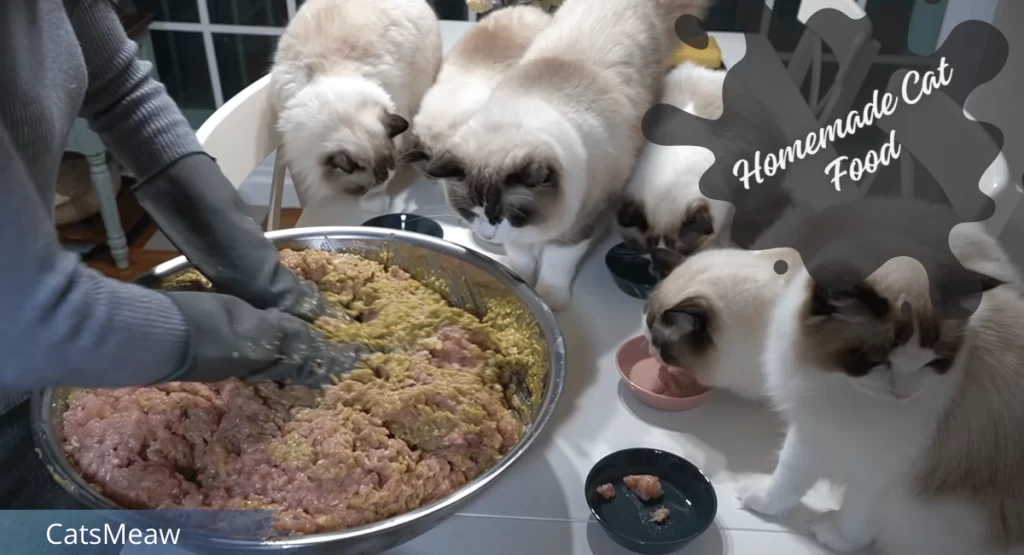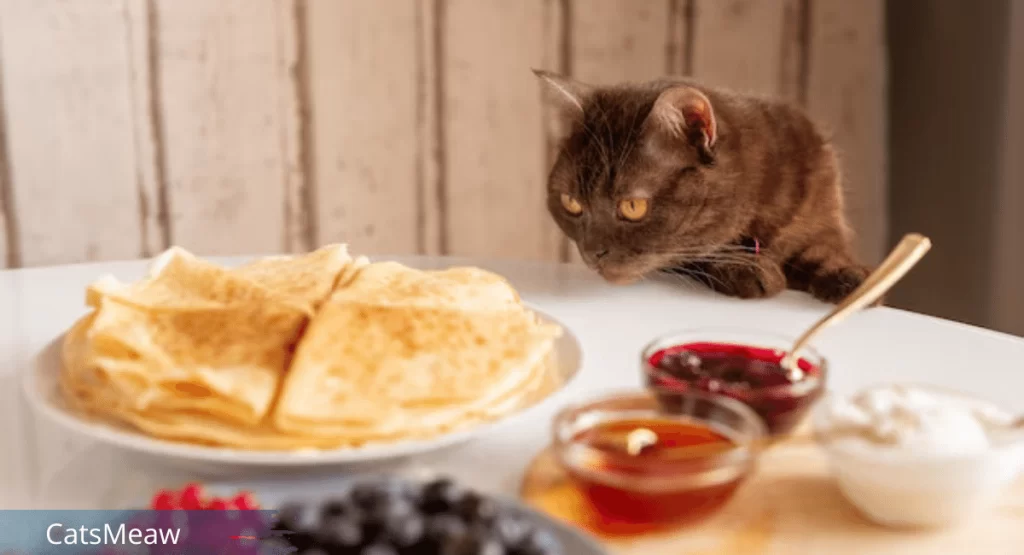As a cat owner, you want nothing but the best for your furry friend. One way to ensure their health and happiness is by preparing homemade cat food. In this comprehensive guide, I will walk you through the benefits of homemade cat food, common mistakes to avoid, essential nutrients for a cat’s diet, homemade cat food recipes for different dietary needs, how to prepare and store homemade cat food, transitioning your cat to a homemade diet, tips for ensuring your cat’s health and well-being on a healthy cat diet, and answer frequently asked questions about homemade cat food.

By the end of this article, you’ll be well-equipped to provide your beloved feline with delicious and nutritious meals.
Table of Contents
1- Why Homemade Cat Food?
Commercial cat food is convenient, but it often contains low-quality ingredients and lacks the essential nutrients that cats need for optimal health. By preparing homemade cat food, you have complete control over the ingredients, ensuring that your cat receives a balanced and nutritious diet. Healthy Cat Diet allows you to cater to your cat’s individual dietary needs, whether they have food allergies, sensitivities, or require a specific diet due to health conditions.
Additionally, preparing homemade cat food can be a bonding experience between you and your furry companion, as you take the time to provide them with a meal made with love.
2- The Benefits of Homemade Cat Food
There are numerous benefits to feeding your cat homemade food. Firstly, you have control over the quality of ingredients used. You can choose high-quality protein sources such as chicken, turkey, or fish, which are essential for your cat’s overall health and well-being. Secondly, homemade cat food allows you to customize the healthy cat diet to meet your cat’s specific needs.
Whether they require a low-carbohydrate diet or have food sensitivities, you can tailor the ingredients to ensure they receive the necessary nutrients. Lastly, homemade cat food can promote better digestion and reduce the risk of urinary tract problems, as you can avoid fillers and additives commonly found in commercial cat food.
3- Common Mistakes to Avoid When Preparing Homemade Cat Food
While preparing homemade cat food can be rewarding, it’s important to be aware of common mistakes that can compromise your cat’s health. One mistake is failing to include essential nutrients in their healthy cat diet. Cats require specific nutrients, including taurine, arachidonic acid, and vitamin A, which are found in animal-based proteins.
Another mistake is not properly balancing the diet. It’s crucial to ensure the correct ratio of proteins, fats, and carbohydrates to meet your cat’s nutritional needs. Additionally, using ingredients that are toxic to cats, such as onions, garlic, and certain spices, can be harmful. Finally, improper storage and handling of homemade cat food can lead to bacterial contamination. It’s essential to follow proper food safety practices to keep your cat safe and healthy.
Related: 7 Most Dangerous foods for cats
4- Essential Nutrients for a Cat’s Diet
To provide your cat with a balanced and nutritious diet, it’s important to understand the essential nutrients they need. Cats are obligate carnivores, meaning they require a diet rich in animal-based proteins. Protein sources like chicken, turkey, and fish should form the foundation of their diet. Additionally, cats need fats for energy and to support healthy skin and coat.
Omega-3 fatty acids, found in fish oil, are particularly beneficial. Carbohydrates should be limited in a cat’s diet, as they have minimal nutritional value for felines. However, some cats may benefit from small amounts of easily digestible carbohydrates, such as cooked rice or sweet potatoes. Finally, cats require certain vitamins and minerals, including taurine, arachidonic acid, and vitamin A, which are vital for their overall health.
5- Homemade Cat Food Recipes for Different Dietary Needs
When preparing homemade cat food, it’s important to consider your cat’s specific dietary needs. Here are a few recipes that cater to different requirements:
Recipe 1: Basic Homemade Cat Food
Ingredients:
- 1 pound of boneless chicken or turkey
- 1/2 cup of chicken broth
- 1/4 cup of cooked carrots
- 1/4 cup of cooked peas
- 1/4 teaspoon of fish oil
Instructions:
- Cook the chicken or turkey until fully cooked and no longer pink.
- In a food processor, blend the cooked meat, chicken broth, carrots, peas, and fish oil until well-combined.
- Serve the homemade cat food immediately, or store it in an airtight container in the refrigerator for up to three days.

Recipe 2: Homemade Cat Food for Sensitive Stomachs
Ingredients:
- 1 pound of lean ground beef
- 1/4 cup of pumpkin puree
- 1/4 cup of cooked quinoa
- 1/4 teaspoon of coconut oil
Instructions:
- Cook the ground beef until fully cooked and no longer pink.
- In a mixing bowl, combine the cooked beef, pumpkin puree, cooked quinoa, and coconut oil.
- Mix well until all ingredients are thoroughly combined.
- Serve the homemade cat food immediately, or store it in an airtight container in the refrigerator for up to three days.
Recipe 3: Homemade Cat Food for Weight Management
Ingredients:
- 1 pound of boneless, skinless chicken breast
- 1/4 cup of cooked green beans
- 1/4 cup of cooked carrots
- 1/4 cup of cooked sweet potatoes
- 1/4 teaspoon of flaxseed oil
Instructions:
- Cook the chicken breast until fully cooked and no longer pink.
- In a food processor, blend the cooked chicken, green beans, carrots, sweet potatoes, and flaxseed oil until well-mixed.
- Serve the homemade cat food immediately, or store it in an airtight container in the refrigerator for up to three days.
6- How to Prepare and Store Homemade Cat Food
Preparing healthy cat diet requires careful planning and attention to detail. Start by consulting with your veterinarian to determine your cat’s specific dietary needs. Once you have a recipe tailored to their requirements, gather high-quality ingredients and ensure proper food safety practices. Cook all meat thoroughly to eliminate any potential bacteria. Be mindful of toxic ingredients such as onions, garlic, and certain spices that can harm your cat.
Related: Feeding Your Cat: Essential Tips for a Healthy Feline
Allow the homemade cat food to cool before serving or storing in airtight containers in the refrigerator. It’s important to note that homemade cat food should not be stored for longer than three days to prevent bacterial growth. If you prefer to make larger batches, consider freezing individual portions and thawing them as needed.
7- Transitioning Your Cat to a Homemade Diet
Transitioning your cat to a homemade diet requires patience and a gradual approach. Start by introducing small amounts of homemade cat food alongside their regular diet. Gradually increase the proportion of homemade food over several weeks, monitoring your cat’s response. It’s normal for cats to experience temporary digestive upset during the transition.
If your cat shows signs of severe discomfort or refuses to eat, consult with your veterinarian for guidance. Remember to make the transition slowly to allow your cat’s digestive system to adjust to the new healthy cat diet.
8- Tips for Ensuring Your Cat’s Health and Well-being on a Homemade Diet
Feeding your cat a homemade diet requires ongoing attention to their health and well-being. Here are a few tips to ensure your cat thrives on a homemade diet:
- Regular vet check-ups: Schedule regular check-ups with your veterinarian to monitor your cat’s health and address any concerns.
- Monitor weight: Keep an eye on your cat’s weight and body condition to ensure they are maintaining a healthy weight.
- Provide fresh water: Always provide your cat with fresh, clean water to prevent dehydration.
- Variety is key: Offer a variety of protein sources and recipes to ensure your cat receives a diverse range of nutrients.
- Observe for allergies or sensitivities: If you notice any signs of allergies or sensitivities, such as skin irritations or digestive issues, consult with your veterinarian to identify potential triggers and make necessary adjustments to the diet.
Conclusion
Feeding your cat homemade food is a wonderful way to provide them with a delicious and nutritious diet. By understanding the benefits of homemade cat food, avoiding common mistakes, ensuring essential nutrients, and following proper preparation and storage techniques, you can give your furry friend the best possible care. Remember to consult with your veterinarian for personalized advice and enjoy the process of preparing healthy cat diet as you bond with your feline companion. Start today and give your cat the gift of a healthy and happy life.
